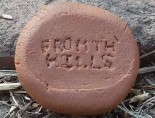Welcome to the studio. I’m Johnny Pickles, and here I want to give you a glimpse into my process for making pottery out of nothing. Absolutely nothing.
Please excuse the mess, this site is still under construction. Pottery is always be a little messy anyway, so let’s get started!
Mining
Normally prospectors destroy the land digging into the deep soil probing for what they want. This would be true for the kaolin prospector as well, except logging roads, gravel pits and other scars on the land everywhere reveal the deep soil of the area. I can usually find a place on every hillside to check out the soil to a depth of three feet or more. Stay away from highways and major roads where herbicides are applied. Trust me, lugging 100 pounds of pristine deposit a mile through the woods is some of the best exercise you can get.
Check the places where water has eroded the road cut, the fine mud will give you a preview of what kind of clay is there.

Refining
Just enough water is added to liquefy the clay into an emulsion. Organic stuff floats to the top and is skimmed off, while the heavy sand settles to the bottom.

Once all the good kaolin is liquefied and skimmed, it is poured into the drying bin through a screen, leaving behind the sandy tailings.

Drying this emulsion and forming it back into a plastic material will take patience. A layer of water will form on the surface which is best removed because this takes away soluble solids (salts) that you don’t want.
Fire!

After the clay is sculpted and totally dry, it is fired in my charcoal process. Nobody showed me how to do this, so I’m not going to show you the rigamarole that took years to work out. Besides, if you’re serious, and not crazy, you would do it the easy way and buy an electric kiln. Screw that. I have plenty of wood to burn, and each piece comes out with unique black ‘kiln stains’ from the resulting charcoal. I use only small-diameter wood that I harvest myself, no waste lumber.
Blow off the ashes, and boom! New pottery.


After firing, pieces are rinsed in cold water and put through the drying process.
That’s all there is to it. Grab your pick hammer and head out to th’ hills!
